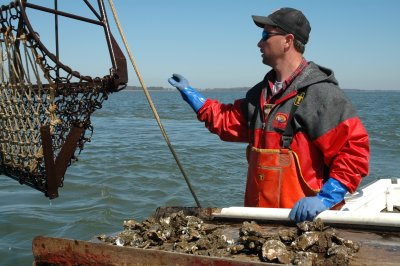
Jeff Baker, an eighth generation waterman from Rock Hall, Md., reaches out to grab the basket of oysters he just pulled from the bay bottom 14 feet down. Photo: Megan Hartley, Capital News Service.
By MEGAN HARTLEY, Capital News Service
ROCK HALL - With the help of his golden retriever, Cap'n, Larry Simns is herding a cluster of 22 white oyster boats over the smooth waters of the Chester River - dropping black flags to make sure the craft, laden with wire baskets, do not wander over oyster bars where they are forbidden to dredge.
On the boats, watermen drop metal cages to the bottom of the river about 14 feet below, and drag them for a few minutes to scoop up a load of oysters. When finally the cages are raised to the surface, the rock-like oysters are dumped on the deck of the boat.
These oysters are not destined for dinner tables or restaurants in Baltimore and Washington. Rather, they are being dredged to make room on Maryland's best oyster beds for new baby oysters less likely to be infected by the diseases that have ravaged the Chesapeake Bay's oyster harvest for the past 50 years.
Mostly because of the disease, efforts to increase the bay's oyster population since the historically low catch in 1994 have been largely unsuccessful. Still, a coalition of legislators, environmentalists, watermen and scientists is refusing to give up, persisting in the effort to make sure that these profitable and eco-friendly mollusks make a comeback.
"We're not gonna get rid of the disease," said Simns, a veteran skipper who has spent his life as a bay waterman and now heads the Maryland Watermen's Association. "We just gotta work around it."
Oysters are the natural filters of the bay, which makes them important to not only watermen, but to anyone else who cares about the health of Maryland's iconic natural symbol. Citizens are starting their own oyster gardens, lawmakers are providing funds to hatch disease-free baby oysters and watermen are planting them in the water.
"It's big news," said Kathy Brohawn, chief of the shellfish certification division at the Maryland Department of the Environment. "Everybody knows oysters are part of the solution to the bay clean up."
The oyster diseases Dermo and MSX are the main cause of the decline of the Chesapeake Bay oyster. A study to come out this year by the Army Corps of Engineers will examine if a disease resistant non-native Asian oyster will have adverse effects on the ecosystem of the bay.
There are other factors for the oyster's current difficulties - sediment, reduced water quality, shrinking habitat - but none so important as disease. Thus, said Tom O'Connell, assistant director of fisheries at the Maryland Department of Natural Resources, "there isn't going to be one solution, we have to use a combination of strategies."
Marylanders, either organized into groups or on their own, are trying their best to help the native oyster make a comeback.
The Chesapeake Bay Foundation, for example, provides workshops where people can learn to grow oysters in baskets off their piers. After a year, the small oysters are planted in a sanctuary.
Steve Gauss, a retired astronomer, took the idea a little further and organized a group of more than 20 residents in Shady Side, Anne Arundel County, to build their own oyster bar in the West River.
"I'm retired and I was looking for something to do that would help the environment," said Gauss. "I live on the bay so helping the bay seemed like a great idea. I really enjoy doing this."
The Chesapeake Bay Foundation also took its case beyond environmentally-conscious people who live on the water to the halls of the State House in Annapolis.
It worked. Lawmakers this session poured funds into the oyster replenishment program by providing $9.2 million to the University of Maryland Center for Environmental Science Horn Point Laboratory, which produces baby oysters or "spat."
A meshed bag filled with spat is put into a tank filled with shells. The spat will swim through the holes of the bag and eventually attach to the shells.
The hatchery then gives the baby oysters to a variety of organizations including: the Oyster Recovery Partnership, Maryland Department of Natural Resources and the Chesapeake Bay Foundation for planting.
Watermen have felt the brunt of the oyster decline, and have struggled to keep their jobs and the unique way of life that comes with it. According to Simns, about 300 to 400 watermen still make a living oystering in the winter by either diving or using hand tongs. In the southern portions of the bay, watermen are allowed to use power dredges.
Simns' Maryland Waterman's Association helps run the Oyster Recovery Partnership, which has been under some heat lately for harvesting most of the oysters they have planted with the help of federal funds.
The partnership plants oysters in sanctuaries, reserves and open bars. Sanctuaries are never to be harvested, reserves are planted and left until the oysters reach 4 inches, but open bars can be readily harvested. A story in The Baltimore Sun said the watermen plant more in reserves and open bars than in sanctuaries so there will be more oysters to harvest for sale - basically making the program a government subsidy for watermen.
However, supporters of the program contend that no one has a single, concrete answer to how to save the native oyster, and the partnership is just an ongoing effort to figure out what to do.
"We are fully supportive of the oyster recovery partnership, it is a great organization to work with and has helped us out significantly," said O'Connell. "There isn't a cookbook for oyster restoration yet, we are using the best science available to try to achieve our objectives."
When oysters die, their shells open up and spread the disease to the other parts of the bar. Watermen argue that harvesting them before they do this, will keep the bar free of disease. The disease is not harmful to humans.
Controversy aside, watermen who used to make a good living off the bay are finding themselves out of work.
Buster Elburn had to stop oystering many years ago because he could not support his family with the declining populations. He went to work on a cattle ranch instead.
"When you grow up on the water and your father is a waterman, it's in your blood," said Elburn. "But it got to the point where I just couldn't support my family anymore."
Jeff Baker, an eighth generation waterman from the little town of Rock Hall on the Eastern Shore where "everyone is related," has been a bit luckier. He still supports his family by oystering in the winter and crabbing in the summer.
But despite the powerful political and popular forces gathering to help save the native oyster, the future still seems grim.
"There has been a tremendous amount of partnerships and funding," said O'Connell. "But despite these significant efforts we have not seen the response that we would have liked, the population is still comparable to what it was in 1994."
RELATED INFORMATION:
Maryland Establishes New Oyster Advisory Commission, September 18, 2007
http://somd.com/news/headlines/2007/6398.shtml


